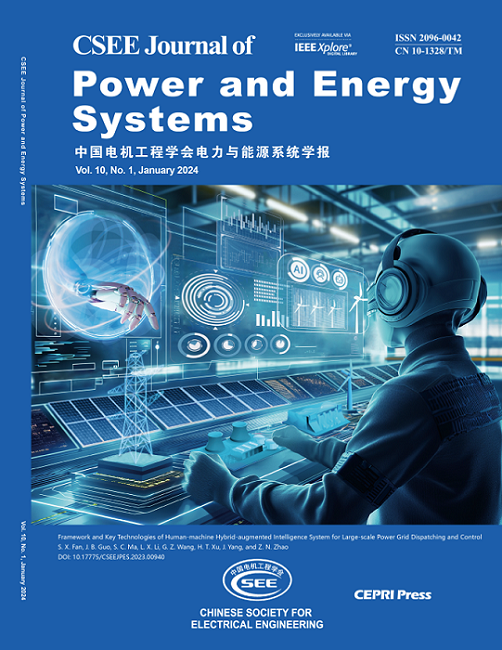大型电力系统暂态稳定区域估计第二部分:具有计算效率的降阶稳定区域
IF 5.9
2区 工程技术
Q2 ENERGY & FUELS
引用次数: 0
摘要
本文的第二部分提出了一种基于降阶稳定区域(ROSR)的估计大型电力系统全阶稳定区域(FOSR)的方法。首先,我们介绍了FOSR和ROSR的定义,然后是一个全面的理论,揭示了它们之间的关系。由于全阶系统可以重写为一个标准的双时间尺度模型,而降阶系统被看作是它的慢子系统,因此基于奇异摄动的思想推导了该理论。通过严格的数学证明,揭示了FOSR和ROSR的性质。此外,采用改进的能量增强动态(EAD)算法和约束等距投影(CEP)方法分别估计了ROSR和FOSR。改进的EAD算法和CEP形成了一种所谓的降阶稳定区域映射(ROSRM)方法。最后,将所提出的ROSRM方法应用于IEEE 10机39总线电力系统,仿真研究证实了该方法在计算速度和结果可靠性方面优于传统能量函数方法。本文章由计算机程序翻译,如有差异,请以英文原文为准。
Estimating Transient Stability Regions of Large-Scale Power Systems Part II: Reduced-Order Stability Region with Computational Efficiency
Part II of this paper presents a reduced-order stability region (ROSR) based method to estimate the full-order stability region (FOSR) of a large-scale power system. First, we introduce the definitions of FOSR and ROSR, followed by a comprehensive theory that reveals the relationships between them. Since the full-order system can be rewritten as a standard two timescale model and the reduced-order system is regarded as the slow subsystem of it, the proposed theory is derived based on the idea of singular perturbation. With rigorous mathematical proof, the properties of FOSR and ROSR are revealed. Moreover, a modified Energy Augmented Dynamic (EAD) algorithm and a constrained equidistant projection (CEP) approach are employed to estimate the ROSR and FOSR, respectively. The modified EAD algorithm and CEP form a so-called reduced-order stability region mapping (ROSRM) method. Finally, the proposed ROSRM method is applied to the IEEE 10-machine-39-bus power system, and simulation studies confirm its superiority to the traditional energy function method in terms of computational speed and reliability of results.
求助全文
通过发布文献求助,成功后即可免费获取论文全文。
去求助
来源期刊

CSEE Journal of Power and Energy Systems
Energy-Energy (all)
CiteScore
11.80
自引率
12.70%
发文量
389
审稿时长
26 weeks
期刊介绍:
The CSEE Journal of Power and Energy Systems (JPES) is an international bimonthly journal published by the Chinese Society for Electrical Engineering (CSEE) in collaboration with CEPRI (China Electric Power Research Institute) and IEEE (The Institute of Electrical and Electronics Engineers) Inc. Indexed by SCI, Scopus, INSPEC, CSAD (Chinese Science Abstracts Database), DOAJ, and ProQuest, it serves as a platform for reporting cutting-edge theories, methods, technologies, and applications shaping the development of power systems in energy transition. The journal offers authors an international platform to enhance the reach and impact of their contributions.
 求助内容:
求助内容: 应助结果提醒方式:
应助结果提醒方式:


